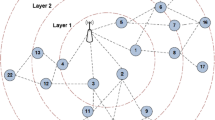Abstract
Recently, multipath routing in wireless sensor networks (WSN) has got immense research interest due to its capability of providing increased robustness, reliability, throughput, and security. However, a theoretical analysis on the energy consumption behavior of multipath routing has not yet been studied. In this paper, we present a general framework for analyzing the energy consumption overhead (i.e., energy tax) resulting from multipath routing protocol in WSN. The framework includes a baseline routing model, a network model, and two energy consumption schemes for sensor nodes, namely, periodic listening and selective wake-up schemes. It exploits the influence of node density, link failure rates, number of multiple paths, and transmission environment on the energy consumption. Scaling laws of energy-tax due to routing and data traffic are derived through analysis, which provide energy profiles of single-path and multipath routing and serve as a guideline for designing energy-efficient protocols for WSN. The crossover points of relative energy taxes, paid by single-path and multipath routing, reception, and transmission, are obtained. Finally, the scaling laws are validated and performance comparisons are depicted for a reference network via numerical results.







Similar content being viewed by others
Notes
These paths may be node-disjoint, link-disjoint, or high-energy path. A certain policy may need necessary modifications at the contents of RREQ and RREP messages.
The RF signal may be sent by a transmitter wishing to transmit data to a receiver node or by local circuitry when local sensors detect some phenomena or event.
The main reason behind achieving this result is that the data traffic is diversified in MPR, which reduces the collision probability and, hence, the number of retransmission attempts at each hop.
References
Mahapatra A, Anand K, Agrawal DP (2006) QoS and energy aware routing for real-time traffic in wireless sensor networks. Comput Commun 29(4):437–445
Felemban E, Lee CG, Ekici E, Boder R, Vural S (2006) MMSPEED: multipath multi-speed protocol for QoS of reliability and timeliness in wireless sensor networks. IEEE Trans Mob Comput 5(6)
Razzaque MA, Alam MM, Rashid MM, Hong CS (2008) Multi-constrained QoS geographic routing for heterogeneous traffic in sensor networks. IEICE Trans Commun E91-B(8):2589–2601
Teo JY, Ha Y, Tham CK (2008) Interference-minimized multipath routing with congestion control in wireless sensor network for high-rate streaming. IEEE Trans Mob Comput 7(9):1124–1137
Nasser N, Chen Y (2007) SEEM: secure and energy-efficient multipath routing protocol for wireless sensor networks. Comput Commun 30(11–12):2401–2412
Ganesan D, Govindan R, Shenker S, Estrin D (2001) Highly-resilient, energy-efficient multipath routing in wireless sensor networks. ACM Mob Comput Commun Rev 5(4):10–24
Li S, Wu Z (2005) Node-disjoint parallel multipath routing in wireless sensor networks. In: Proc international conference on embedded software and systems (ICESS), pp 432–437
Gao Q, Blow KJ, Holding DJ, Marshall I (2005) Analysis of energy conservation in sensor networks. Wirel Netw 11:787–794
Feeney LM (2001) An energy consumption model for performance analysis of routing protocols for mobile ad hoc networks. Mob Netw Appl 6:239–249
Luo J, Jiang L, Chen H (2008) Analysis of the energy-QoS tradeoff for contention-based wireless sensor networks with synchronous wakeup patterns. IEICE Trans Commun E91B(8):2711–2715
Hou TY, Shi Y, Pan J, Midkiff SF (2006) Maximizing the lifetime of wireless sensor networks through optimal single-session flow routing. IEEE Trans Mob Comput 5(9):1255–1266
Nasipuri A, Das SR (1999) On demand multi-path routing in mobile ad hoc networks. In: IEEE ICCN’99, pp 64–70
Wu X, Chen G, Das S (2008) Avoiding energy holes in wireless sensor netowrks with nonuniform node distribution. IEEE Trans Parallel Distrib Syst 19(5):710–720
Liu X, Haenggi M (2006) Toward quasiregular sensor networks: toplogy control algorithms for improved energy efficiency. IEEE Trans Parallel Distrib Syst 17:975–986
Anandkumar A, Yukich JE, Tong L, Swami A (2008) Scaling laws for statistical inference in random networks. In: Proc of allerton conf on communication, control and computing, Monticello
Mueller S, Tsang RP, Ghosal D (2004) Multipath routing in mobile ad hoc networks: issues and challenges. Lect Notes Comput Sci 2965:209–234
Chiasserini CF, Rao RR (2001) Combining paging with dynamic power management. In: IEEE INFOCOM
Heinzelman W (2000) Application-specific protocol architectures for wireless networks. Ph.D. thesis, Dept of Electrical Eng and Computer Science. Massachusetts Inst of Technology
Bertsekas D, Gallager R (1992) Data networks, ex 2.13, 2nd edn. Prentice Hall, Englewood Cliffs
Yates RD, Goodman DJ (2005) Probability and stochastic processes, B.6. Wiley, New York
Zhao Q, Tong L (2005) Energy efficiency of large-scale wireless networks: proactive versus reactive networking. IEEE J Sel Areas Commun 23(5):1100–1112
Acknowledgements
This work was partially supported by the Korea Science and Engineering Foundation (KOSEF) grant funded by the Korea government (MEST) (No. R01-2008-000-20801-0) and by the UCN Project, Knowledge and Economy Frontier R&D Program of MKE in Korea as a result of UCN’s subproject 09C1-C2-10M. Dr. C. S. Hong is the corresponding author.
Author information
Authors and Affiliations
Corresponding author
Rights and permissions
About this article
Cite this article
Razzaque, M.A., Hong, C.S. Analysis of energy-tax for multipath routing in wireless sensor networks. Ann. Telecommun. 65, 117–127 (2010). https://doi.org/10.1007/s12243-009-0110-5
Received:
Accepted:
Published:
Issue Date:
DOI: https://doi.org/10.1007/s12243-009-0110-5




